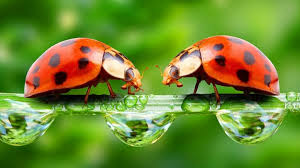
A Loveliness of Ladybugs
descended on the field,
to feast upon each flower's foes,
and guard my garden's yield.
I watched them dance in crimson gowns
with polka dots of black.
They twirled and swirled to current tunes,
then sought a midday snack.
To clear the aphids from each rose,
they stalked them on the stalks.
And topped the meal with mealy bugs
and fiends that feed on phlox.
Then sipped the dew - seems munching mites
might cause a mighty thirst.
Begrudge them not small berry bites;
they ate the fruit flies first!
The gnats waylaid, wee eggs were laid
right in the pests' own nests.
A hatchling banquet soon ensued
for uninvited guests.
Dear Ladybugs nee Lady Birds
I'd watched all summer long,
with hope they'd winter in my house,
. . . and not believe the song.
"Your house is not afire," I said,
"your children safely grown."
But one fall day I rose to find
my Loveliness had flown.
|
Author Notes
The collective noun for a group of ladybugs is called a loveliness. I couldn't resist.
In the US, we call them Ladybugs, however in other English-speaking countries they may call them Lady Birds.
Most ladybugs voraciously consume plant-eating insects, such as aphids, and in doing so they help to protect crops. They also lay hundreds of eggs in the colonies of aphids and other plant-eating pests. When they hatch, the ladybug larvae immediately begin to feed. They do love to nibble on berries, but rarely leave a mark.
The children's song:
Ladybird, ladybird fly away home,
Your house is on fire and your children will burn,
All except one, and her name is Ann,
And she hid under the baking pan.
|
|




